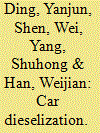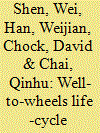|
|
|
Sort Order |
|
|
|
Items / Page
|
|
|
|
|
|
|
| Srl | Item |
| 1 |
ID:
125745


|
|
|
|
|
| Publication |
2013.
|
| Summary/Abstract |
Recently, there is a renewed interest in car dieselization in China to address the challenge of oil security. We developed an econometric model to estimate the vehicle fuels and crude oil demands. The results indicate that if the average travel distance of cars is maintained at the level of 2010-16,000 km/yr, and if the distillation products mix of the refineries remains unchanged, China's crude oil demand in 2020 will reach 1060 million tonnes (Mt), which also results in an excess supply of 107 Mt of diesel. A new balance of diesel supply and demand can be reached and crude oil demand can be significantly reduced to 840 Mt by improving the production ratio between diesel and gasoline on the supply side and promoting passenger vehicle dieselization on the demand side. The crude oil demand will be reduced to 810 Mt in 2020, if the vehicle travel distance gradually drops to 12,000 km/yr. If so, dieselization will provide a rather limited added value-only 6% further oil saving by 2020. Dieselization is not a silver bullet but it depends on a series of key factors: growth rate of gross domestic products (GDP), vehicle sales, and vehicle annual travel distance.
|
|
|
|
|
|
|
|
|
|
|
|
|
|
|
|
| 2 |
ID:
119819


|
|
|
|
|
| Publication |
2013.
|
| Summary/Abstract |
Considering natural gas (NG) to be the most promising low-carbon option for the energy industry, large state owned companies in China have established numerous coal-based synthetic natural gas (SNG) projects. The objective of this paper is to use a system approach to evaluate coal-derived SNG in terms of life-cycle energy efficiency and CO2 emissions. This project examined main applications of the SNG and developed a model that can be used for evaluating energy efficiency and CO2 emissions of various fuel pathway systems. The model development started with the GREET model, and added the SNG module and an end-use equipment module. The database was constructed with Chinese data. The analyses show when the SNG are used for cooking, power generation, steam production for heating and industry, life-cycle energies are 20-108% higher than all competitive pathways, with a similar rate of increase in life-cycle CO2 emissions. When a compressed natural gas (CNG) car uses the SNG, life-cycle CO2 emission will increase by 150-190% compared to the baseline gasoline car and by 140-210% compared to an electric car powered by electricity from coal-fired power plants. The life-cycle CO2 emission of SNG-powered city bus will be 220-270% higher than that of traditional diesel city bus. The gap between SNG-powered buses and new hybrid diesel buses will be even larger-life-cycle CO2 emission of the former being around 4 times of that of the latter. It is concluded that the SNG will not accomplish the tasks of both energy conservation and CO2 reduction.
|
|
|
|
|
|
|
|
|
|
|
|
|
|
|
|
| 3 |
ID:
115656


|
|
|
|
|
| Publication |
2012.
|
| Summary/Abstract |
A well-to-wheels life cycle analysis on total energy consumptions and greenhouse-gas (GHG) emissions for alternative fuels and accompanying vehicle technologies has been carried out for the base year 2010 and projected to 2020 based on data gathered and estimates developed for China. The fuels considered include gasoline, diesel, natural gas, liquid fuels from coal conversion, methanol, bio-ethanol and biodiesel, electricity and hydrogen. Use of liquid fuels including methanol and Fischer-Tropsch derived from coal will significantly increase GHG emissions relative to use of conventional gasoline. Use of starch-based bio-ethanol will incur a substantial carbon disbenefit because of the present highly inefficient agricultural practice and plant processing in China. Electrification of vehicles via hybrid electric, plug-in hybrid electric (PHEV) and battery electric vehicle technologies offers a progressively improved prospect for the reduction of energy consumption and GHG emission. However, the long-term carbon emission reduction is assured only when the needed electricity is generated by zero- or low-carbon sources, which means that carbon capture and storage is a necessity for fossil-based feedstocks. A PHEV that runs on zero- or low-carbon electricity and cellulosic ethanol may be one of the most attractive fuel-vehicle options in a carbon-constrained world.
|
|
|
|
|
|
|
|
|
|
|
|
|
|
|
|
|
|
|
|
|